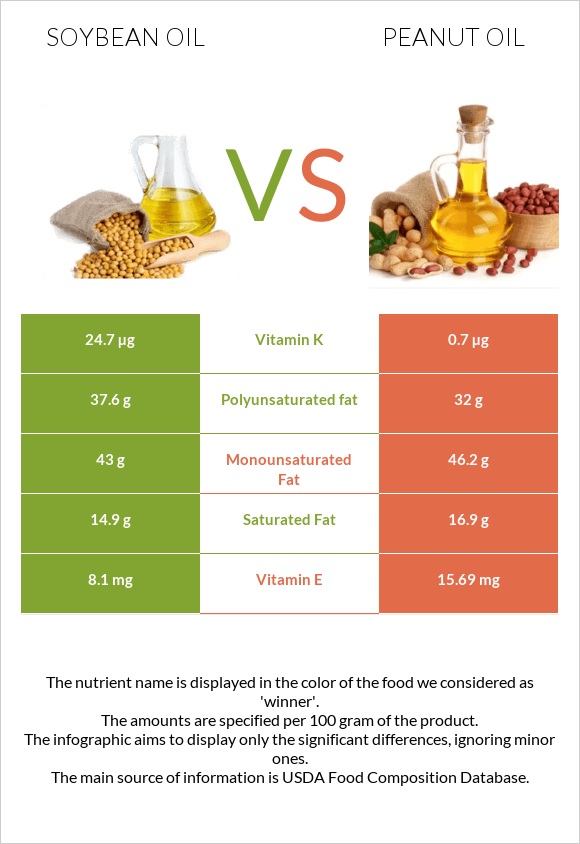Peanut Oil vs. Soybean Oil: What’s the Difference?


Summary
Peanut oil is richer in monounsaturated fats, whereas soybean oil is richer in polyunsaturated fats and lower in saturated or unhealthy fats.
Peanut oil has nearly 2 times more vitamin E, whereas soybean oil is 35 times richer in vitamin K.
Both these oils have high smoke points and can be used for frying. Each provides several health benefits.
Introduction
This article compares 2 types of vegetable oils: peanut oil, also known as groundnut oil or arachis oil, and soybean oil. They will be compared according to their general differences, nutritional content, and health impacts.
By the end of the article, the reader will understand which is a better option for different usages and make a healthy decision.
General differences
Smoke Point, Use & Taste
One of the main features of oils is their smoke point. It is essential to know their smoke point to understand how to use these oils and prevent the production of harmful components and unpleasant flavors.
Soybean and peanut oils have similar smoke points, which may vary somewhat due to the oil's quality, purity, and processing method.
The approximate smoke point of soybean oil is 234°C (453°F), whereas, for peanut oil, it is 232°C (450°F). Both oils can be used for deep frying and baking and withstand high temperatures.
Both oils generally have a mild or neutral taste. However, if the peanut oil is made from roasted peanuts, it usually has a stronger peanut taste and aroma.
Nutrition
The nutritional values in this article are presented for 100g of peanut oil and soybean oil (partially hydrogenated).
The average serving size of cooking oils is one tablespoon, equal to 13.5g for each oil, or one teaspoon, equal to 4.5g.
Macronutrients & Calories
Both oils consist of 100% fat, are thus absent in carbohydrates and protein, and provide 884 calories per 100g serving.
One average serving, or one tablespoon, of soybean and peanut oils contains 13.5g of fats, nearly 85% of which are unsaturated, and provides 120 calories.
Peanut oil is richer in monounsaturated fats, whereas soybean oil is richer in polyunsaturated fats and slightly lower in saturated or unhealthy fats.
Fat Type Comparison
Contains
less
Sat. FatSaturated fat
-11.8%
Contains
more
Poly. FatPolyunsaturated fat
+17.5%
Vitamins & Minerals
Both peanut oil and soybean oil are abundant in vitamin E; peanut oil has nearly 2 times more vitamin E. Soybean oil is 35 times richer in vitamin K, while peanut oil contains insignificant amounts.
Peanut oil also contains negligible amounts of zinc and iron. Both oils are absent in other minerals and vitamins.
We can visualize their distribution in the diagram below.
Vitamin Comparison
Contains
more
Vitamin KVitamin K
+3428.6%
Contains
more
Vitamin EVitamin E
+93.7%
Health Impact
One of the most severe issues with oils is that they raise the risk of atherosclerosis. Peanut and soybean oil, on the other hand, are high in unsaturated fatty acids, notably polyunsaturated fatty acids. As a result, compared to other oils, these fats lower the risk of atherosclerosis.
These oils are healthy alternatives to traditional oils high in saturated fats (1, 2).
Vitamin E Benefits
Vitamin E acts as an antioxidant and lowers the risk of various diseases, including cancer. It also has immune-boosting properties (3).
Vitamin K Benefits
Soybean oil's vitamin K has various functions in the body. It provides anticarcinogenic and bone-forming characteristics. The anti-calcification properties of vitamin K2 may reduce the risk of atherosclerotic calcifications (4).
Vitamin K is also essential in coagulation or blood clotting. Its deficiency may increase the risk of bleeding. On the other hand, those on anticoagulants, such as Warfarin, are advised to consume consistent amounts of vitamin K (5).
Metabolic health
Replacing saturated fatty acids with unsaturated fatty acids lowers the risk of hypertension, atherosclerosis, diabetes, liver disease, and obesity.
According to research, switching from saturated to polyunsaturated fats lowers the risk of diabetes, hypertension, atherosclerosis, and obesity more than switching from saturated to monounsaturated fats. As a result, soybean oil has an extra benefit over peanut oil (6, 7).
References
- https://pubmed.ncbi.nlm.nih.gov/20546405/
- https://www.ncbi.nlm.nih.gov/pmc/articles/PMC5587404/
- https://www.ncbi.nlm.nih.gov/pmc/articles/PMC3997530/
- https://pubmed.ncbi.nlm.nih.gov/26468402/
- https://ods.od.nih.gov/factsheets/VitaminK-HealthProfessional/
- https://pubmed.ncbi.nlm.nih.gov/27578132/
- https://pubmed.ncbi.nlm.nih.gov/28635680/
Infographic

Mineral Comparison
All nutrients comparison - raw data values
| Nutrient |  |
 |
DV% diff. |
| Vitamin E | 8.1mg | 15.69mg | 51% |
| Polyunsaturated fat | 37.6g | 32g | 37% |
| Vitamin K | 24.7µg | 0.7µg | 20% |
| Saturated fat | 14.9g | 16.9g | 9% |
| Monounsaturated fat | 43g | 46.2g | 8% |
| Calories | 884kcal | 884kcal | 0% |
| Fats | 100g | 100g | 0% |
| Iron | 0mg | 0.03mg | 0% |
| Zinc | 0mg | 0.01mg | 0% |
| Choline | 0.2mg | 0.1mg | 0% |
Macronutrient Comparison
People also compare
References
All the values for which the sources are not specified explicitly are taken from FDA’s Food Central. The exact link to the food presented on this page can be found below.
- Soybean oil - https://fdc.nal.usda.gov/fdc-app.html#/food-details/171012/nutrients
- Peanut oil - https://fdc.nal.usda.gov/fdc-app.html#/food-details/171410/nutrients
All the Daily Values are presented for males aged 31-50, for 2000-calorie diets.





